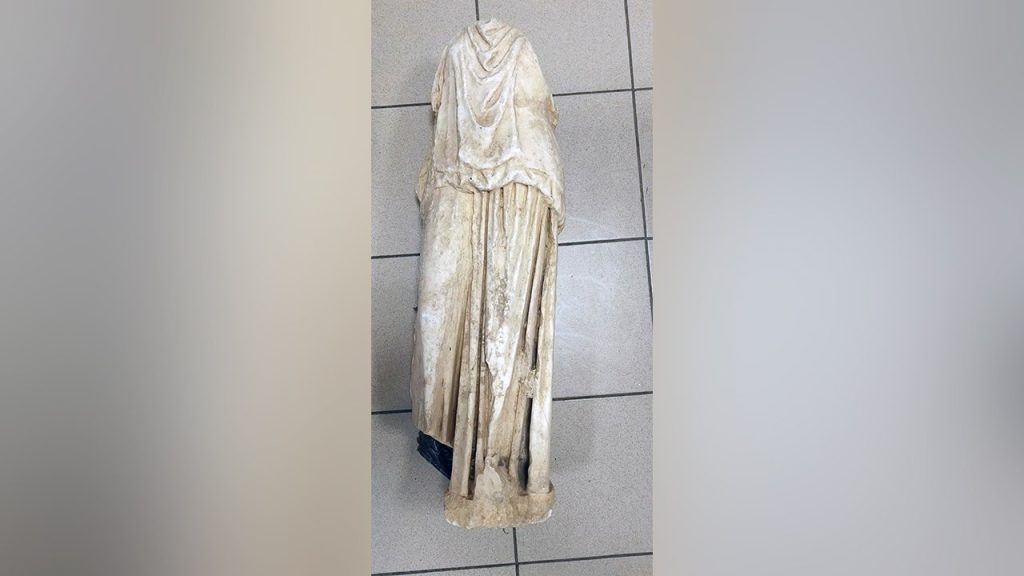The discovery of a Hellenistic-era marble statue discarded in a garbage bag near Thessaloniki, Greece, has sparked both intrigue and concern. A resident stumbled upon the headless, 80-centimeter statue beside a trash bin in Neoi Epivates and promptly alerted authorities. Archaeologists, after an initial assessment, dated the statue to the Hellenistic period (circa 320-30 B.C.), a period renowned for its artistic and cultural flourishing following Alexander the Great’s conquests. The statue has been sent for further examination and will ultimately be entrusted to the local antiquities authority for preservation and scholarly study. Police initiated an investigation to identify the individual responsible for discarding the statue, briefly detaining a man who was subsequently released without charge. This incident highlights the ongoing challenges of protecting cultural heritage, even in a nation steeped in ancient history.
The Hellenistic period, marking the transition from Classical Greece to the rise of the Roman Empire, witnessed a significant evolution in artistic styles and themes. Sculptures from this era often exhibit a greater degree of emotional expression and realism compared to the idealized forms of the Classical period. The discovery of this statue, albeit under unfortunate circumstances, offers a tangible connection to this pivotal era and provides valuable insights into the artistic trends and cultural practices of the time. The headless state of the statue, while unfortunate, is not uncommon in archaeological finds. Damage from time, weather, and intentional defacement or looting often contribute to the fragmentation of ancient artifacts.
The discovery of the Hellenistic statue underscores the prevalence of accidental archaeological finds in Greece, a nation rich in ancient history. These serendipitous encounters with the past often occur during construction projects, highlighting the intricate layering of history beneath the modern landscape. For instance, in December, workers installing natural gas pipelines near Athens unearthed a Roman-era statue of Hermes, illustrating the unexpected nature of such discoveries. The frequent uncovering of antiquities during construction underscores the importance of incorporating archaeological surveys and mitigation measures into development projects to protect and preserve these invaluable remnants of the past.
Thessaloniki, Greece’s second-largest city, recently unveiled a remarkable collection of antiquities discovered during the protracted construction of its metro system. The unveiling coincided with the official opening of the metro in November. The unearthed treasures include a marble-paved Roman thoroughfare and tens of thousands of artifacts spanning the Greek, Byzantine, and Ottoman periods. These finds, now prominently displayed at various subway stations, offer a captivating glimpse into the city’s rich and multifaceted history, transforming the metro into an underground museum. This integration of archaeological discoveries into public spaces provides a unique opportunity for the public to engage with their heritage in a tangible and accessible way.
The unintentional discovery of the Hellenistic statue near Thessaloniki also serves as a poignant reminder of the ongoing struggle against the illicit antiquities trade. While the circumstances surrounding the statue’s disposal remain unclear, the possibility of looting or theft cannot be ignored. The illegal trafficking of cultural heritage objects poses a significant threat to the preservation of historical artifacts and deprives nations of their patrimony. International efforts to combat this illicit trade are crucial to safeguarding cultural heritage for future generations. The return of 30 ancient artifacts worth $3.7 million to Greece by the United States exemplifies the importance of international cooperation in repatriating stolen cultural property.
The recent discoveries in Greece, including the Hellenistic statue and the trove of antiquities unearthed during the metro construction in Thessaloniki, underscore the importance of continued archaeological exploration and preservation efforts. These finds provide valuable insights into the region’s rich and complex history, spanning millennia. They also highlight the need for ongoing public awareness campaigns to educate individuals about the significance of protecting cultural heritage and reporting any suspected looting or illegal activity. The collaboration between local communities, authorities, and archaeologists is crucial in ensuring the preservation and appreciation of these invaluable links to the past.

